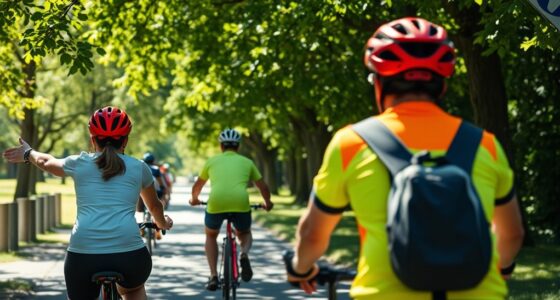Cycling events boost your local economy by increasing sales, creating jobs, and attracting tourists. They enhance community engagement through volunteer roles and cultural activities, fostering stronger neighborhood ties. These events promote healthier lifestyles, support local businesses, and encourage environmental sustainability by reducing car usage. Infrastructure improvements like bike lanes also benefit everyone long-term. To discover how these events can transform your community further, explore the many social and environmental impacts they bring.
Key Takeaways
- Cycling events boost local economies through increased retail sales, hotel bookings, and temporary job creation.
- They enhance community engagement and civic pride via volunteer roles and cultural activities.
- Events promote active lifestyles, improving public health and reducing obesity rates.
- They support local businesses by increasing foot traffic and fundraising opportunities for charities.
- Cycling events foster environmental sustainability by reducing vehicle emissions and promoting eco-friendly transportation.
Economic Benefits and Job Opportunities

Cycling events provide clear economic benefits to communities by boosting local businesses and creating jobs. When these events occur, nearby retail shops, restaurants, and hospitality services often see sales increase by up to 50%. This surge benefits the local economy directly. Hosting major cycling races also attracts visitors from outside the area, leading to higher hotel bookings and restaurant patronage. Additionally, organizing these events creates temporary jobs in planning, security, transportation, and hospitality sectors, which can sometimes lead to ongoing employment. Moreover, cycling events often spur infrastructure improvements that support active transportation and regional access, fostering long-term economic growth. These improvements can include the development of cycling-friendly infrastructure, which benefits residents and visitors alike. Investing in active transportation infrastructure not only enhances safety but also encourages healthier lifestyles and sustainable urban development. Overall, these events energize the local economy by increasing spending, employment, and infrastructure development, making communities more vibrant and economically resilient.
Growing Tourism and Destination Promotion
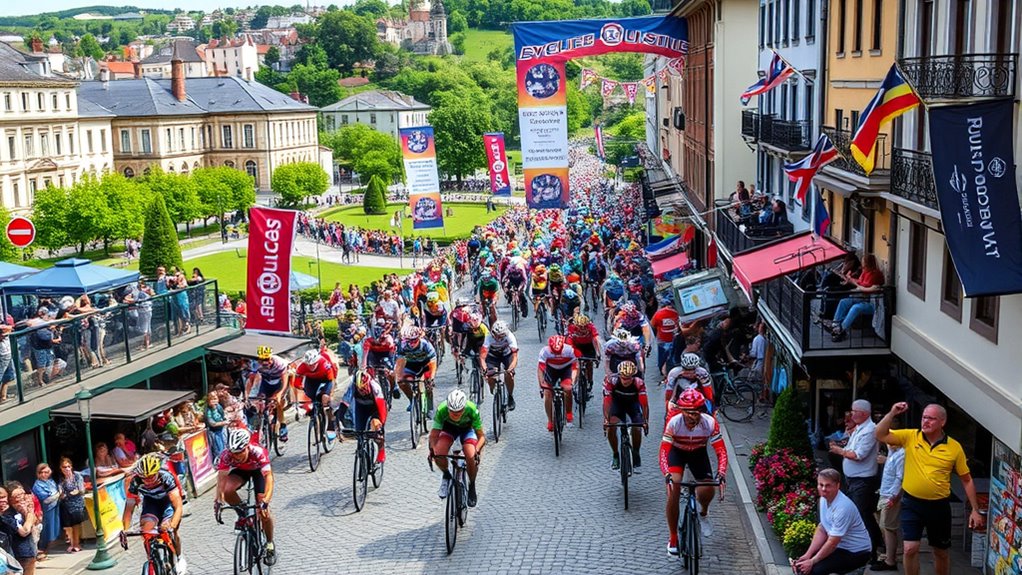
Hosting cycling events not only boosts the local economy through increased spending and job creation but also substantially elevates the community’s profile as a travel destination. These events attract participants from far away, increasing tourism and supporting local hospitality sectors. Major races like the Maryland Cycling Classic and Tour of America’s Dairyland garner media coverage that highlights your community as a prime cycling destination. Additionally, local foods, arts, and cultural exhibits featured during events promote regional products and attract visitors seeking authentic experiences. Cycling festivals and races become annual traditions, encouraging repeat visits and fostering destination loyalty. Infrastructure improvements, such as new trails and bike-friendly facilities, further enhance tourism appeal and support sustainable growth. Promoting cycling-friendly infrastructure can significantly increase a community’s attractiveness to both tourists and residents. Understanding how Gold IRA investments can diversify local economies may also encourage community development initiatives centered around sustainable and resilient growth. Strengthening community engagement and fostering a sense of local pride can further elevate the community’s reputation as a premier cycling destination. Moreover, leveraging insights from AI in retail success can help local businesses better tailor their offerings to visiting cyclists and tourists. Furthermore, investing in sustainable transportation options can ensure the long-term environmental and economic benefits of hosting such events.
Community Engagement and Volunteerism
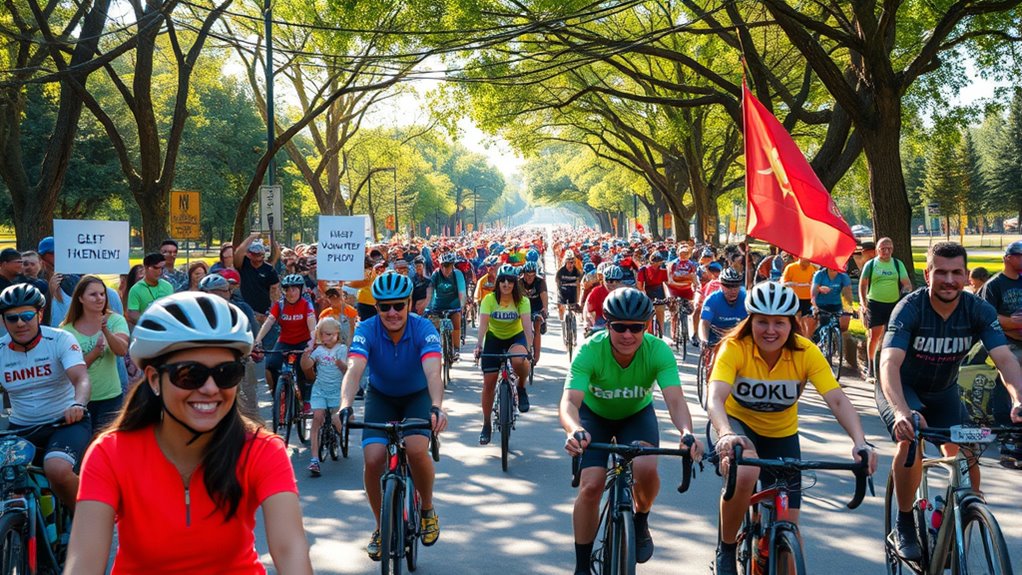
Community engagement and volunteerism play a crucial role in the success of cycling events, as residents often step up to support various roles like route management, hospitality, and event staffing. Your participation not only helps the event run smoothly but also fosters stronger neighborhood bonds. When you volunteer, you gain new skills and develop a sense of ownership, boosting civic pride and encouraging ongoing community involvement. Your involvement in planning and supporting these events demonstrates a collective commitment to local development and healthy lifestyles. Additionally, volunteers and residents working together enhance social cohesion and create a shared purpose within the community. Cycling events also serve as platforms for local businesses and charities, with volunteers actively supporting fundraising and outreach efforts that benefit everyone. Promoting community resilience through active participation helps communities better adapt to challenges and foster long-term sustainability. Transparency regarding financial relationships is essential to maintain trust and integrity within community-driven initiatives. Encouraging open communication about funding sources can further strengthen community trust and ensure equitable resource distribution. Integrating cultural intelligence strategies can further improve collaboration among diverse community members, leading to more inclusive and effective event planning. Moreover, leveraging home furnishings knowledge can help in organizing comfortable and accessible resting areas for volunteers and attendees, enhancing overall event experience.
Health and Wellness Initiatives
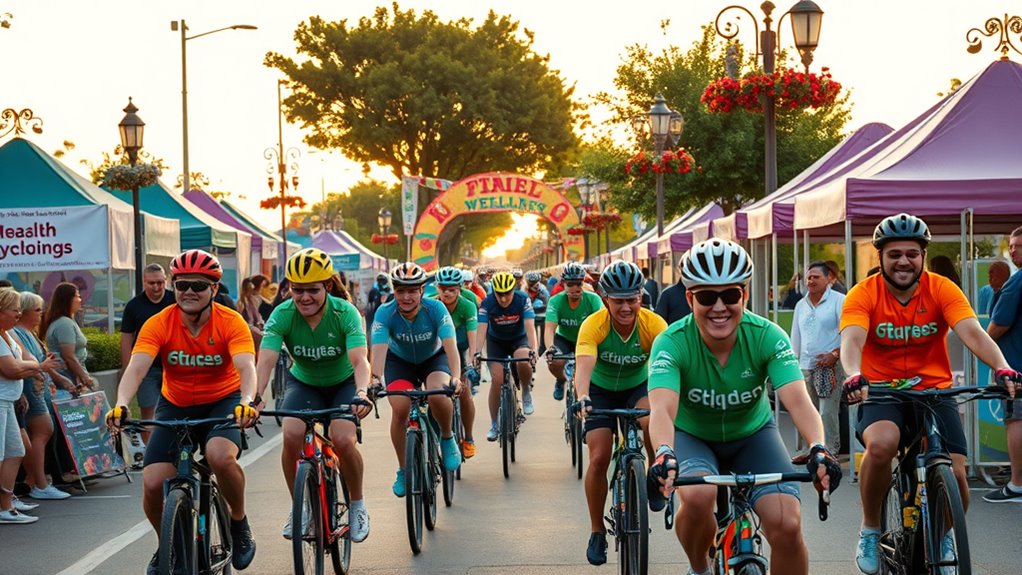
Cycling events motivate you to adopt healthier habits and stay active. They often include free health screenings and fitness classes that support community wellness. By participating, you help foster a culture of active living that benefits everyone’s health. Incorporating airless spray technology into community projects can also promote efficient and eco-friendly painting practices. Additionally, promoting awareness of essential oils for health can complement wellness initiatives by offering natural options for symptom relief and relaxation. Understanding the benefits of Gold IRA Rollovers can further secure your financial wellness for the future. Recognizing the positive impact of dog-friendly environments can enhance community engagement and encourage responsible pet ownership during events. Moreover, the presence of security systems in community spaces can improve safety during large gatherings, ensuring a secure environment for all participants.
Promoting Active Lifestyles
Participating in cycling events can considerably boost your active lifestyle by encouraging regular physical activity. These events promote healthy living by motivating communities to stay active through organized rides, races, and wellness activities like fitness classes and nutrition seminars. When you join local cycling events, you’re more likely to increase your daily activity levels and develop long-term healthy habits. Communities benefit from this culture of health, as residents become inspired to incorporate cycling into their routines. Data shows that cities hosting cycling events see higher rates of active transportation and lower rates of obesity and related health problems. By engaging in these events, you help foster a community that values wellness and active living, making healthier choices a normal part of everyday life. Additionally, promoting healthy habits through community engagement can lead to sustained improvements in public health outcomes. Furthermore, these initiatives often serve as a catalyst for social cohesion, strengthening neighborhood bonds and encouraging shared goals for healthier living. Such events also provide opportunities for education on nutritional awareness, further supporting community health. Interestingly, the rise of professional sports like WWE Raw and the increasing wealth of athletes and entertainers highlight how financial success can influence community engagement and motivation for healthy lifestyles.
Encouraging Community Fitness
Engaging in community cycling events can markedly boost your overall health and wellness by encouraging active lifestyles. These cycling events promote community fitness by motivating participants to stay active through participation and training. Many events also include free fitness classes, health screenings, and nutrition seminars, which foster a culture of wellness. After taking part in these activities, you often feel more motivated to maintain regular exercise routines. Cycling events serve as great platforms to highlight the mental health benefits of physical activity, such as reducing stress and elevating mood. The social aspect of community cycling events further enhances community cohesion, helping everyone work toward shared health and fitness goals. By participating, you contribute to a healthier, more connected community.
Infrastructure Improvements and Bike-Friendly Development

Investing in bike-friendly infrastructure transforms communities by making cycling safer and more accessible. By adding dedicated bike lanes and expanding trail networks, you create a more welcoming environment for cyclists, encouraging more people to ride. These improvements boost the local community’s economy, with studies showing a 12.64% rise in retail employment along bike corridors in Minneapolis. Scenic bikeways and protected lanes attract cycling tourists, increasing revenues for small businesses in places like La Crosse and Wausau. Cities that prioritize bike infrastructure often see food sales along bike corridors surge by over 50%. Additionally, regional bikeways crossing scenic landscapes foster community bonding and regional tourism. Strategic investments, such as bike parking and safe crossings, make cycling a sustainable, essential part of daily life.
Supporting Local Businesses and Retail Growth
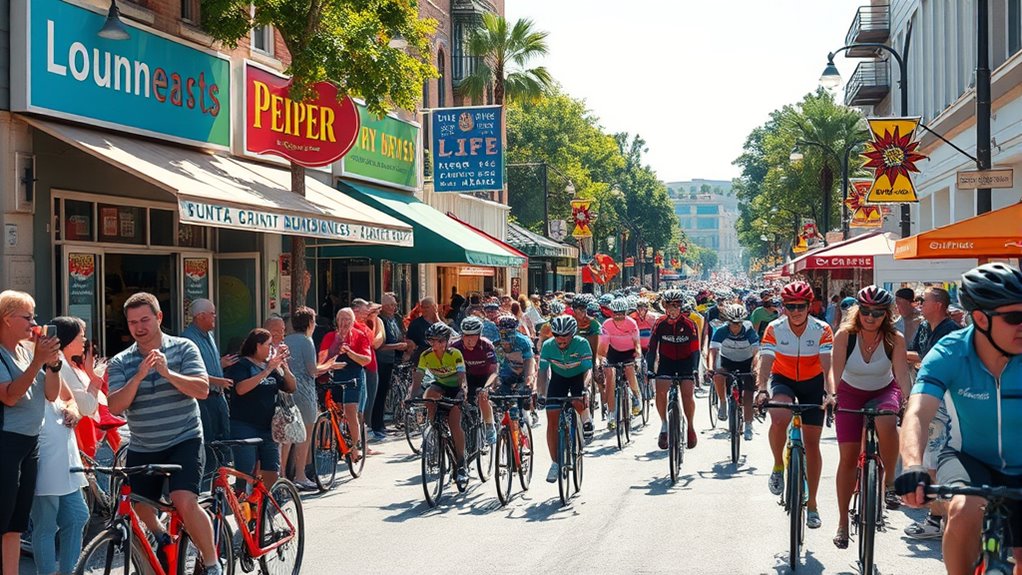
When cycling events come to town, you’ll notice a boost in retail revenue as visitors buy from local shops and eateries. These events also create a surge in hospitality demand, filling hotels and increasing spending in restaurants. Over time, the increased visibility can lead to sustained growth for your community’s businesses.
Boosts Retail Revenue
Cycling events bring a surge of visitors that considerably boosts retail revenue in local communities. As foot traffic increases, you’ll notice local shops, restaurants, and services experience a significant sales jump. During major races like the Tour of America’s Dairyland, nearby businesses see sales rise by up to 30%, directly benefiting the retail sector. Retailers report a 20-25% revenue boost during event weekends, highlighting the immediate economic impact. Vendors and sponsors also enjoy increased sales from event-related merchandise, food, and drinks, fueling the local economy. This influx of visitors not only provides short-term gains but can also promote long-term retail growth by elevating community profile and encouraging repeat tourism, making cycling events a powerful tool for supporting local retail and economic vitality.
Increases Hospitality Demand
Cycling events draw visitors from outside the community, markedly increasing demand for local hotels, restaurants, and retail shops. This surge in hospitality needs means more bookings, higher sales, and lively streets during events. Hotels often see occupancy rates soar, sometimes for days after the race, supporting local accommodations. Restaurants and cafes experience a spike in customers, serving both participants and spectators. Retail shops, especially those selling cycling gear, souvenirs, or local food, benefit from increased foot traffic. Events like the Tour of America’s Dairyland prove that cycling festivals can boost hospitality demand considerably, leading to a ripple effect across local businesses. As a result, these events not only elevate the profile of the community but also create sustained economic growth through heightened hospitality activity.
Charitable Fundraising and Social Impact
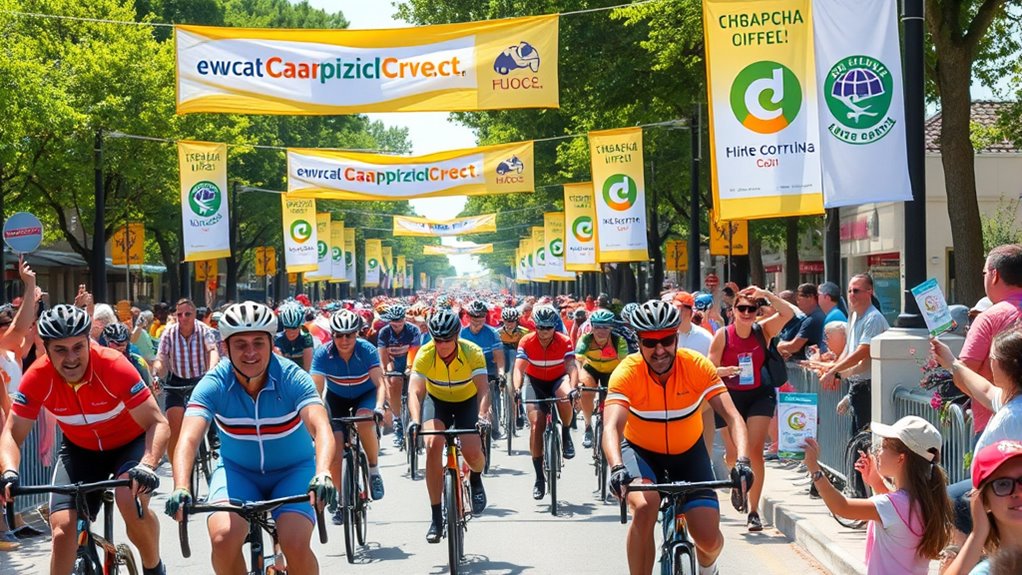
Have you ever considered how cycling events can do more than just showcase athleticism? They often serve as powerful tools for charitable fundraising and creating social impact. By organizing races like the Chequamegon 40 or the Wisconsin Off-Road Series, communities raise significant funds for local charities, including food banks, shelters, and healthcare programs. Participants and volunteers contribute to these causes, strengthening community bonds and boosting social cohesion. These events foster a sense of pride and collective effort, helping nonprofits and social services thrive. Furthermore, the funds generated support initiatives that improve community well-being and resilience. Cycling events, thus, go beyond sport—they become catalysts for positive change, uniting communities around shared goals and making a tangible difference in people’s lives.
Environmental Advantages of Cycling Events
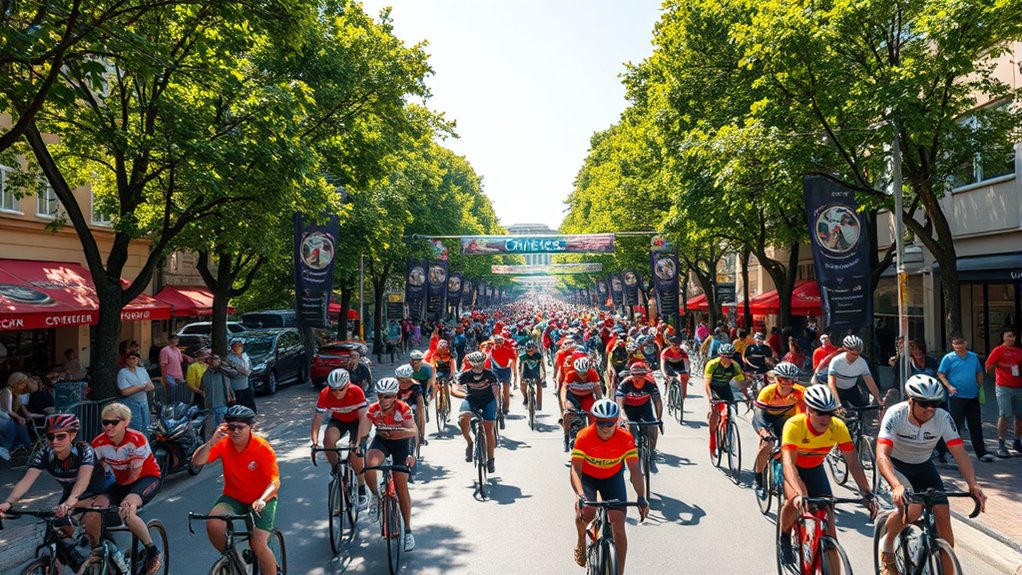
Building on the social impact of cycling events, their environmental benefits are equally significant. By promoting eco-friendly transportation, you help reduce reliance on cars, which decreases air pollution and greenhouse gas emissions. During these events, participants and organizers often adopt sustainability practices like waste reduction and using renewable resources, further supporting environmental goals. Increased awareness among attendees encourages sustainable habits beyond the event, fostering long-term eco-friendly behaviors. Reduced vehicle traffic during cycling events leads to less traffic congestion and lower emissions in host areas. Hosting these events also supports local environmental initiatives, demonstrating the community’s commitment to sustainability. Overall, cycling events provide a clear environmental impact, helping communities become greener and more mindful of their ecological footprint.
Strengthening Community Identity and Cohesion
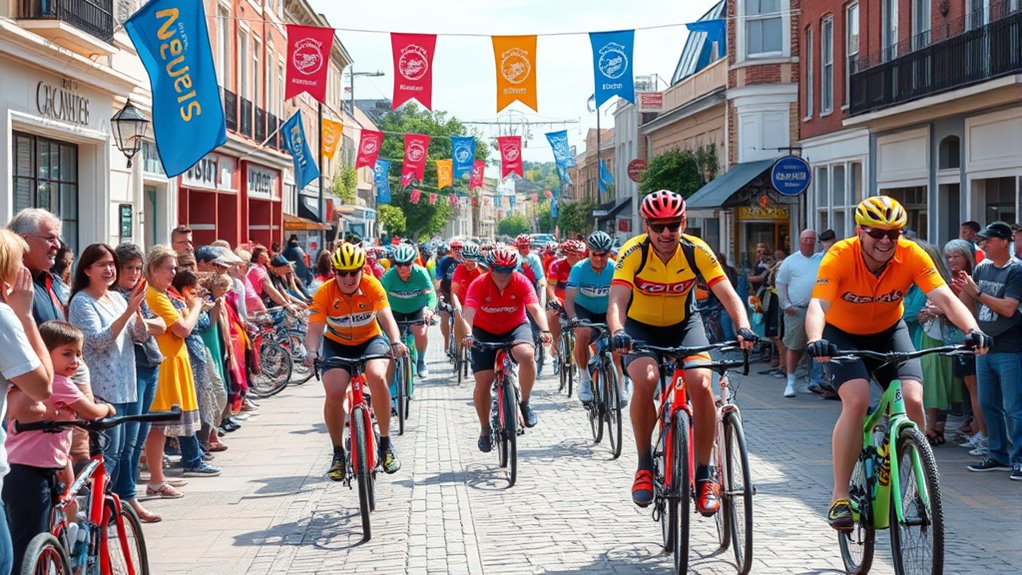
Hosting cycling events brings communities together, fostering a strong sense of identity and pride. As you participate, you’ll notice how residents unite around shared interests and local culture, boosting community cohesion. Volunteer opportunities during these events encourage you and others to get involved, strengthening social bonds within your neighborhood. Large cycling events highlight local landmarks, arts, and traditions, showcasing what makes your community unique to visitors and participants. These events promote interaction among diverse groups, creating a more inclusive environment rooted in active, healthy living. Data shows that communities hosting cycling events experience increased social capital, with residents feeling greater attachment and pride in their neighborhood. By coming together, you help build a resilient, vibrant local community where everyone feels connected and valued.
Frequently Asked Questions
What Impact Did the Bicycle Have on Society?
You might wonder how the bicycle impacted society. It revolutionized transportation by providing an affordable, efficient way to travel, giving people greater mobility and independence. The bicycle also promoted health and fitness, encouraging active lifestyles. Additionally, it fostered social interactions and community cohesion. Over time, bicycles helped reduce traffic congestion and pollution, making cities more livable. Overall, bicycles transformed daily life and contributed to societal progress and environmental sustainability.
Why Is Cycling Good for the Community?
You’ll find that cycling benefits your community in many ways. It encourages healthier living by promoting physical activity, which can reduce healthcare costs. Cycling also boosts local businesses as visitors spend money on hotels, restaurants, and shops. Plus, it fosters community pride and social bonds, bringing residents together to celebrate and participate. Overall, cycling makes your community more vibrant, active, and attractive to both residents and visitors.
What Are the Social Impacts of Biking?
Imagine biking as planting seeds in your community garden. With every pedal stroke, you cultivate stronger bonds, invite new friends, and nurture shared pride. Biking encourages social interaction, making diverse groups feel connected. It’s a way to raise awareness about local issues and promote inclusivity. As you ride, you’re not just moving forward—you’re growing a more engaged, vibrant community where everyone’s voice is heard and valued.
What Is the 75 Rule in Cycling?
The 75 Rule in cycling suggests you shouldn’t ride at more than 75% of your maximum heart rate during training. This helps you avoid overexertion, ensuring your workouts are sustainable and safe. By monitoring your heart rate and staying below this threshold, you improve your endurance and reduce injury risk. Incorporating the 75 Rule into your training plan promotes consistent progress and keeps you cycling efficiently over time.
Conclusion
By embracing cycling events, you become part of a vibrant tapestry that weaves economic growth, health, and community spirit together. These events aren’t just rides—they’re catalysts for change, transforming your neighborhood into a thriving hub of opportunity and unity. Like a well-oiled bicycle chain, each contribution keeps the momentum moving forward. So, get involved, pedal forward, and watch your community blossom into a place where everyone rides toward a brighter future.




